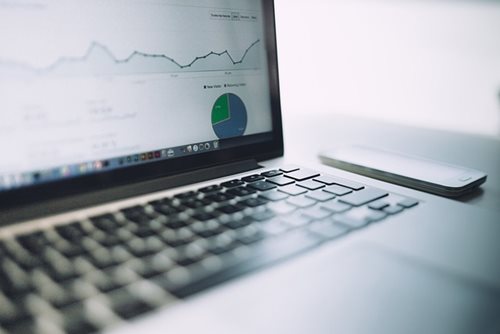Get your free consultation today!
Share with your Colleagues
Categories
ROI Calculator
Moonstone Interactive is the only San Francisco Bay Area web design firm and Internet Marketing expert that offers a free online ROI Calculator
Author: Steve Herz

Conversion rate optimization (CRO) increases the percentage of visitors who convert into actions like purchases, subscriptions, and trial sign-ups. You may already know the significance of the conversion rate statistic, but the question "how to calculate conversion rates" may baffle you.
Every website's ultimate aim is conversion rate optimization. Therefore, you should be able to determine the conversion rate, either manually or with a CRO solution. After all, if your visitors aren't using your services, why use visitor monitoring and click tracking?
What Are Conversion Rates?
A conversion rate displays the proportion of site visitors or landing page viewers that convert by doing the desired action. Some examples of conversion, which may vary based on the kind of business and the objectives you have in mind, are:
- buying something
- enrolling in your newsletter
- completing a form
- establishing a profile
- downloading content
- subscribing or upgrading
Types of Conversion Rates
You may believe that you only need to know how many visits turn into customers. Calculating conversion rates involves much more. You need to have the data for various scenarios and conversions to assess your company's state accurately. So, let's examine the different conversions:
Macro Conversions
We often make incremental steps toward our ultimate aim when creating goals. Macro conversions are the final results considered while determining conversion rates, such as a completed sale and revenue,
In other words, macro conversions are the website objectives that demonstrate a website's performance. This objective statement and a tracking system form the structure to evaluate the financial performance of a website.
Micro Conversions
Micro-conversions include any further conversions or the baby steps you take to attain the primary selling objective. Essentially, this kind of conversion is an activity that can be measured and strongly influences a prospective client to convert to a paying client.
Micro-conversions can take many forms, as listed above in the bullet points. Even though this kind of conversion doesn't give you money immediately, understanding how to calculate and measure this conversion enables you to determine whether the visitors are at the proper stage of your conversion funnel.
Components of Conversion Rate
The four major components of CRO are conversion research, website persuasion, user experience (UX), split-testing (A/B) testing, and customization. Effectively using them will raise your chances of increasing conversions and, consequently, your sales.
To improve the outcomes of CRO, especially conversion research, all of these components interact with one another and build upon one another. For instance, conclusions from conversion research can improve personalization and A/B testing concepts.
Conversion Research
Research is the most crucial component of CRO that enables you to achieve optimization successfully. Conversion research data gives you insights and suggestions for improvement. Web analytics, heat maps, visitor records, surveys, user testing, and professional CRO assessments provide this data.
Website Persuasion
Don't merely hope that visitors to your website will convert. Use copywriting best practices and influencing strategies, such as social proof, scarcity, urgency, and reciprocity, to engage and convert more visitors.
User Experience (UX)
Utilize best practices to improve your website's navigation, forms, and user flow to enhance user experience so visitors can browse and convert more easily. It does not matter if your website is convincing or high on the search engine results page (SERP). The objective is to attract your target prospects, fulfill their wants, and convert them.
A/B testing and customization
The best user experience for your website is found and shown using A/B tests and personalization approaches. The fact that so many websites don't have enough traffic or conversions makes this beneficial but unnecessary.
What Do You Need To Calculate Conversion Rate
When calculating conversion rates, it is crucial to use accurate and pertinent data. The two components of relevant or meaningful data when discussing how to get conversion rates are:
- The Total Number of Guests
- The Total Number of Conversions
Easy Formula to the Calculation
If you are wondering how to calculate conversions, it is easy. The number of conversions divided by the total number of visits yields the conversion rate. A conversion rate is also always expressed as a percentage. Therefore, the formula is:
|
Conversion rate = |
Total Conversions |
X 100 |
|---|---|---|
|
Total Guests |
The appeal is that you may compute the conversion rate formula for digital marketing in any particular location and get the answers to the following:
- The conversion rate overall: How well does your website convert visitors from different sources?
- The conversion rate for marketing channels: Is traffic from Facebook ads or Google ads more likely to convert?
- The conversion rate at the page level: Which of these pages converts visitors better?
- The conversion rate for a campaign: Has anything changed after I changed my targeting?
- The Ad conversion rate per person: Does my Ad copy need to be changed? Do these ads attract more targeted visitors?
- The conversion rate for keywords: What keywords need more significant funding?
Step-By-Step Conversion Rate Calculation and Example
Consider two fiercely competitive online retailers, each receiving 100 orders in the previous month.
The two rival companies, "Company A" and "Company B," both sell goods online at the same price of $150.00 per order.
Conversion Rate = 100 Orders
$150.00 is the average order value (AOV).
The differential, or site traffic, is really in the monthly total of visitors to their website.
Traffic to Company A's Website = 5,000 Viewers
Site traffic for Company B = 500,000 viewers
The two sites receive significantly different amounts of site visitors; therefore, it makes sense that their conversion rates would also differ significantly.
The conversion rate calculation for Company A is 100/5,000 = 2.00%
The conversion rate calculation for Company B is 100/500,000 = 0.02%
As you can see above, Company A has a much better conversion rate than Company B.
Why Is Conversion Rate Important, and Why Should You Calculate It?
A website's conversion rate is one of the most crucial KPIs (key performance indicators). So, to clarify why it is essential to learn how to calculate conversion rates correctly, we will go into more detail about the importance of this statistic.
It Shows How Effective Your Marketing Efforts Are
Conversion rates evaluate the success of your marketing initiatives. Learning what proportion of your visitors accomplish the objectives that drive your business can also help you assess the success of your website or app and identify areas that need development.
The conversion rate will increase if more transactions are closed with the same quantity of visitors. Consider spending $5,000 monthly on advertising to bring 500 people to your website.
The prices will increase if you aim to double your conversion rate through advertising. Therefore, you have two options: lower your advertising budget and spend more on other tactics or additional money on new advertising campaigns.
It Prevents Cart Abandonment
Are you perplexed why some of your consumers do not complete the entire checkout process? Do you wish there was an easy solution? Don't worry; knowing how to measure conversion rates can help you identify and fix the problems that cause potential consumers to leave their shopping carts empty.
Then, you build a conversion rate optimization plan to increase the percentage of visitors completing the checkout process.
It Saves You Time and Money
The conversion rate, as previously noted, gauges the effectiveness of your marketing initiatives. Making people want to go forward with you in their customer journey is a crucial component of marketing.
Knowing how to calculate conversion rate marketing enables you to assess your performance in getting visitors through your funnel. The more frequently customers progress through your conversion funnel, the more significant your ROI (Return on Investment).
Higher ROI means more money in your account and more time on your hands. Additionally, regularly tracking your website's conversion rate enables you to identify any flaws in your marketing strategy and save time by avoiding time-wasting tactics.
Conversion Rate Interpretation
Increasing your conversion rate will increase your sales efficiency since it tracks the percentage of visitors who took action.
In general, above-market conversion rates signal that the current marketing approach is attracting the proper clients to the website (i.e., drawing in the correct target audiences to sell to) and that the audience receives the sales pitch or "message" well.
Among other things, the industry, audience demographics, and overall site traffic all define what makes a "good" conversion rate. A company with a bigger total addressable market (TAM) will have more website traffic (and fewer "targeted" viewers).
Therefore, it makes sense that an online firm offering a niche product would strive for a much greater conversion rate than one with a broad product line and reach. However, the dependence on a more significant conversion rate decreases as a business's website traffic increases; hence, they often aim for lower conversion rates.
Naturally, the conversion rate would drop over time as a website expands and its site traffic (the number of visitors) rises, much to how a company's growth rate declines as it nears the end of its life cycle.
Need help in creating your website for making conversions? Contact us for more details.


